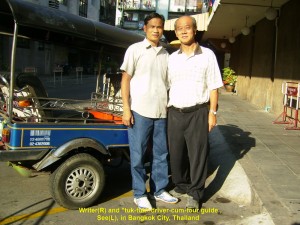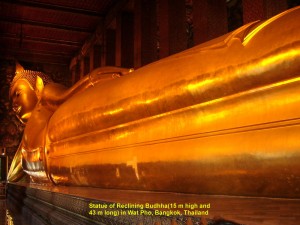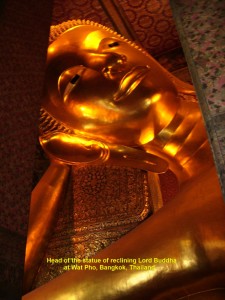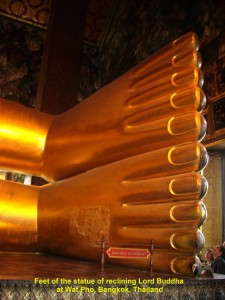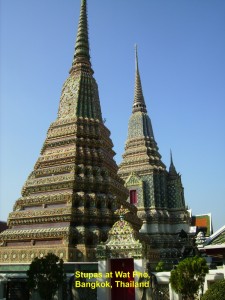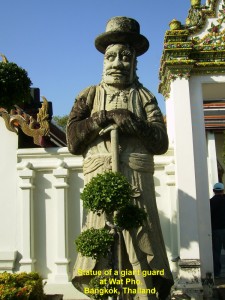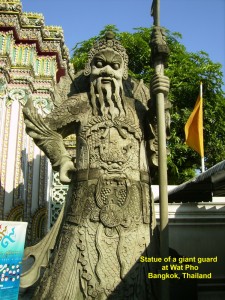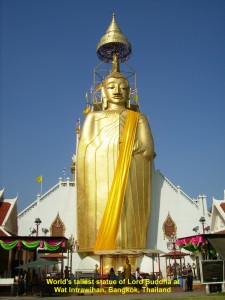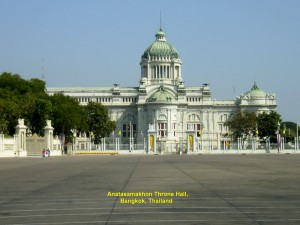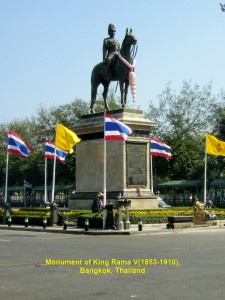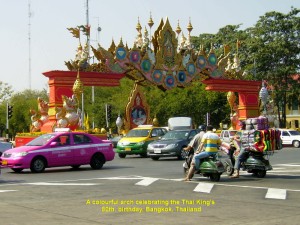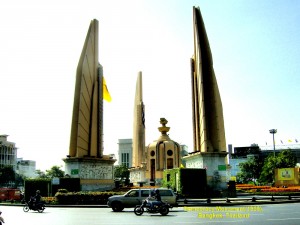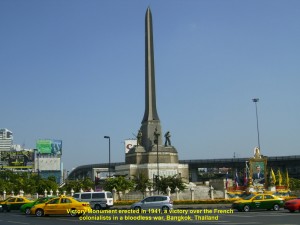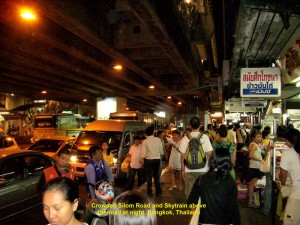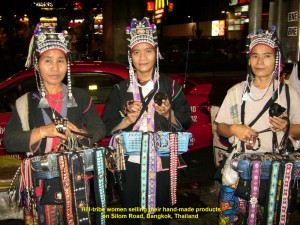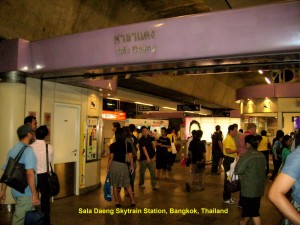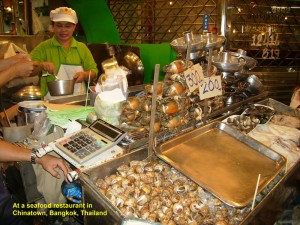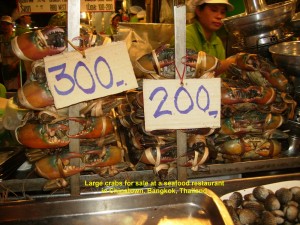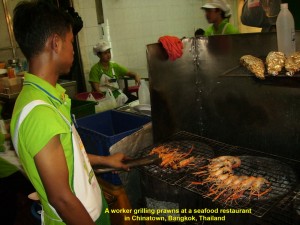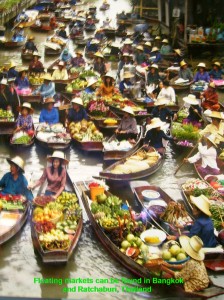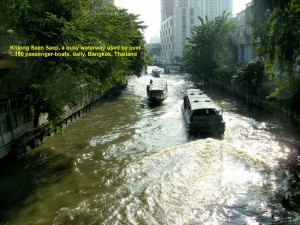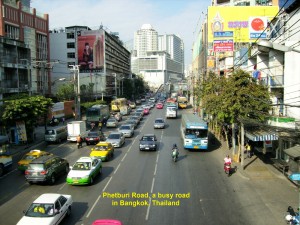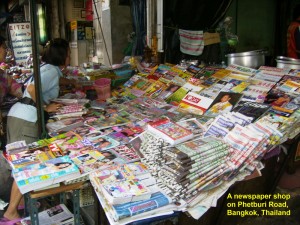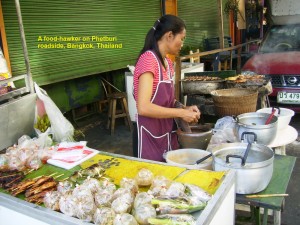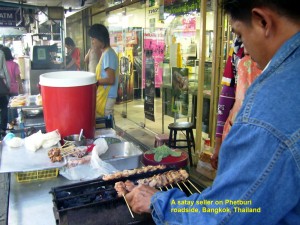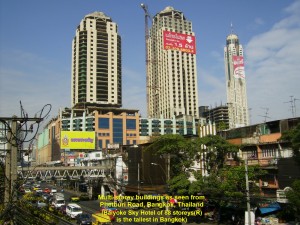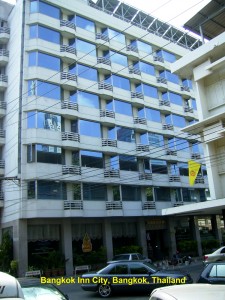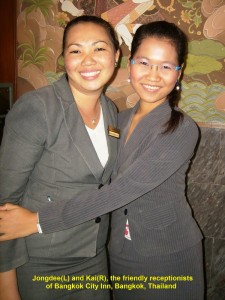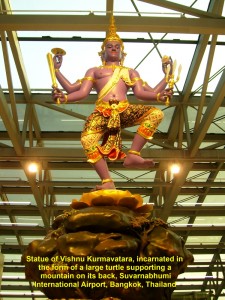Bangkok , Ayuthaya Travel (Part II)
Filed under: Ayuthaya Travel (Part II), Bangkok, Uncategorized
[continued from Bangkok , Ayuthaya Travel (Part I)]
Bangkok , Ayuthaya Travel (Part II)
Day 3 : Thursday, 6 December 2007
On the morning of 6 December 2007, we hired a “tuk-tuk” to bring my wife and I around the city for sightseeing. A young Thai man named See was our “tuk-tuk” driver and our tour-guide too.
The first place he brought us was the famous Grand Palace. When we arrived there we felt extremely disappointed to be informed that the palace, a Thai’s icon, was closed to public then. It was going to hold the Thai King’s 80th. birthday celebration. The palace is truly a grand and stunning one. Below is the description of it:
The Grand Palace
Located on the eastern bank of River Chao Phraya in the Rattanakosin District, this beautiful palace in a large area of over 200 000 sq. metres is surrounded by a high and unfriendly-looking white wall.
The Grand Palace was built in 1782 during the reign of King Rama I (1737-1802) who used it as his royal residence. Subsequently, other Thai kings lived there too from the 18th. century till the middle of the 20th. century.
The last king to live there was King Rama VIII or King Ananda Sun Mahidol(1925-1946). The present king, King Bhumibol Adulyadej (King Rama IX), who succeeded him (his brother) does not live there. Instead, he lives at another place not far from the old one and is known as Chitralada Palace.
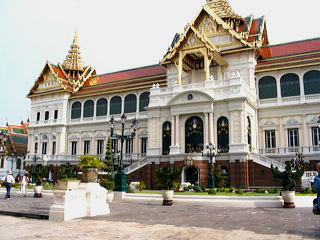
The Grand Palace, Bangkok
The Grand Palace is now used for religious, state and royal ceremonies. It has several buildings built in unique Siamese architectural style.
The Emerald Buddha Temple (Wat Phra Kaew)
In the compound of the Grand Palace is Thailand’s grandest and most sacred Buddhist temple known as Wat Phra Kaew. Built in 1785, it houses a Buddha statue known as Emerald Buddha Statue. There are other statues, such as monkey kings and giants resembling the characters in the Ramayana mythology, around the golden temple. Besides, artworks from art masters during the Rattanakosin era are displayed here.
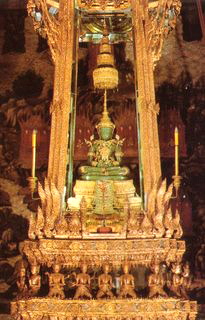
The Emerald Statue of Buddha, Bangkok
As we could not visit the Grand Palace and Wat Phra Kaew we visited a famous temple known as Wat Pho or Wat Phra Chetuphon nearby.
Wat Pho or Wat Phra Chetuphon (Temple of the Reclining Buddha)
Wat Pho houses a large reclining Buddha statue of 46 metres long. The walls inside the temple are beautifully painted with colourful pictures depicting the Buddhist way of life of the Thai people.
This temple has a monastery for the monks. Besides, it is the birthplace of the traditional Thai massage school. Around this temple are several beautiful stupas and large statues of guards with serious looks at some entrances of the temple.
Having completed the tour of this temple, we headed north-east to another famous temple, Wat Intrawihan
Wat Intrawihan
Located at 114, Wisutkasat Road in Phra Nakhon District, Wat Intrwihan was built towards the end of the Ayutthaya Period. Standing tall in the compound is a large golden statue of Buddha. It was built in the reign of King Rama IV in 1867 and completed in the reign of King Rama VII. It claims to be the world’s tallest standing Buddha statue and is known as Phra Si Ariyamettraiya or Luangpor Toh.
While we were at the temple we were shocked to see many cats and dogs roaming
freely in the compound and their excreta was all over the place. As we walked around the temple we were careful not to step on it.

Wat Intrawihan
Anantasamakhon Throne Hall
Located in the Dusit District is a majestic building of marble built in the Italian Renaissance style. It was constructed during the reign of King Rama V and completed in the reign of King Rama VI.
It receives foreign dignitaries and holds the Royal Advisory Council meetings. It was once used for parliamentary meetings.
In 2006, royal personages from 25 countries celebrated King Bhumibol Adulyadej’s 60th. anniversary of monarchy reign at this building. He is the world’s longest reigning king.
King Rama V Monument
In front of Anantasamakhon Throne Hall is a large open space known as Royal Plaza. In the centre there is a monument of an equestrian statue of King Rama V (King Chulalongkorn) in a field marshal uniform. The Thai people loved him so much that they raised fund to get the statue cast by a French sculptor in Paris and placed it there in 1908 when he was still alive.
King Rama V (1853-1910) succeeded his father in 1868. He had travelled to many foreign countries in Asia and Europe and learned about their reforms and governments. With that knowledge he modernized his government. Besides, he abolished slavery in his country. In 1896 he built the first railroad in Thailand connecting Bangkok and Ayutthaya. His subjects called him “The Great Beloved King”.
During his reign he had four queen consorts and some royal common wives. He was the only Thai king who had the most number of children, about 77. His second son, Vajiravudh (1881-1925), succeeded him as the sixth king (King Rama VI) of the Chakri Dynasty in 1910.
Not far from the monument, we saw a colourful arch with a large royal emblem at its top at the crossroads of Ratchadamnoen Nok Road and Si Ayutthaya Road. It was erected to celebrate the Thai king’s 80th. birthday. We also saw four horsemen, police and many people lining the roads from Chitralada Palace to the Grand Palace. They were wearing yellow T-shirts and holding national flags and yellow royal flags waiting to cheer their king. The king who would pass them while he was on his way to the Grand Palace to celebrate his 80th. birthday.
{To the Thais, yellow symbolizes devotion to their beloved king. On the evening of the previous day (5 December 2007), the king’s birthday was celebrated nationwide with festivities and prayers, and thousands of people packed the streets near the Grand Palace to watch a spectacular firework display.}
Democracy Monument
Located on a large roundabout where Ratchadamnoen Klang Road, Prachathipatai Road and Bandinsor Road meet, is the Democracy Monument. It was erected in 1939 to commemorate the June 1932 military coup which resulted in the establishment of the constitutional monarchy.
In the centre of the monument is a turret which has two golden offering bowls on its top. The “1932 Constitution” is on the top bowl. There are four wing-like structures standing round the turret. They represent the army, navy, air force and police guarding the Constitution.
Victory Monument
There is another monument not far from the Democracy Monument. It is known as the Victory Monument which was erected in 1941 on Bangkok’s largest roundabout where Phahon Yothin Highway, Phaya Thai Road, Ratchawithi Road and Din Daeng Road converge. This monument commemorated the Thai victory in a brief, bloodless war with the French colonialists in Indo-China. The victory led to Thailand annexing some territories in western Cambodia, and northern and southern Laos. Some of these territories were formerly Thailand’s and ceded to France in 1883 and 1904.
The monument has 5 human statues standing round a tall obelisk. The statues symbolically represent the army, navy, air force, police and civilians.
Mahboonkrong Centre(MBK Centre)
After the interesting Bangkok City tour, we went to a popular shopping centre known Mahboonkrong Centre(MBK Centre) which is near BTS Central Station (Siam).
There are a few more shopping centres near it, e.g. Siam Centre, Siam Discovery Centre and Siam Paragon. Later, we went back to our hotel to have a rest.
Silom Road
In the evening, my wife and I went to Silom Road by “tuk-tuk” again as it could manoeuvre easily in a traffic jam and reach any place quickly.
Silom Road is in the heart of the Central Business District of Bangkok. Multi-storey buildings line the road. They house banks, trading companies, insurance companies, finance companies, law firms, shopping centres, luxurious hotels, etc.
The road is full of traffic and the walkways are always crowded during day and night. This place is easily accessible by either Rama 6 Road (an expressway), Rama 4 Road or the Skytrain.
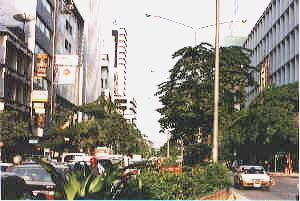
Silom Road during the day
When night falls roadside food stalls and other stalls appear and attract influxes of visitors both locals and tourists. Most of the tourists would head for the red light district of Patpong which is very near to the Sala Daeng Skytrain Station.
Patpong
Patpong has two short roads, Patpong 1 Road and Patpong 2 Road, which are parallel to each other and sandwiched in between Silom Road and Surawong Road.
Patpong belongs to the Patpongpanich family. It is estimated to be worth over US $100 millions! When the family bought it in 1946 they built a road, Patpong Road, and shophouses for rent along the road.
A Red Light District
Later in 1968 the whole area was transformed into a red light district catering mainly for the U.S. soldiers who needed recreation and recuperation (R & R) after their duties in Vietnam during the Vietnam War (1965-1975). Its notoriety spread far and wide by word of mouth in the 1970s and 1980s. In fact, the place has been featured in many western movies such as Deer Hunter (1978) and Miss Saigon(1989). Besides, many authors have written about it in their novels.
Since the Vietnam War was over in 1975 the place has become a tourist attraction and many foreign tourists as well as Thais like to patronize the bars there.
Night Market
In the 1980s, the enterprising Patpongpanich family set up stalls for rent in the middle of Patpong 1 Road. These stalls are now a busy night market selling goods ranging from souvenirs, caps, T-shirts and shoes to jewellery and watches. Their presence has affected the night entertainment business of the bars there.
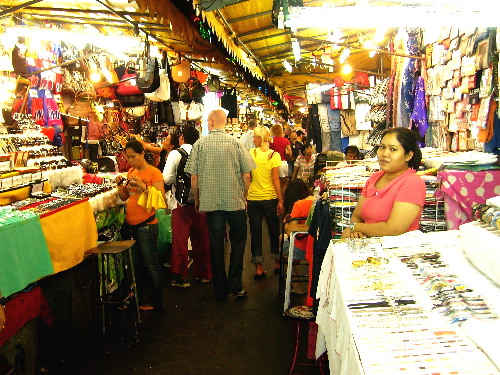
Night market in the Patpong Red Light District
Hard Bargain
From Silom Road, my wife and I walked to Patpong 1 Road. There were many stalls on the latter road which was closed to traffic. Stopping at one of them, my wife thought of buying a child’s frock for our grand-daughter. She was shocked when she was told by the seller that it cost 850 baht! After a few minutes of bargaining she was finally offered 200 baht. Tourists should make a hard bargain there if they want to buy something, otherwise they may be fleeced by unscrupulous sellers.Then we decided to see the bars along Patpong Road. As we were walking past a few of them and trying to get a glimpse of some activities inside, some touts were inviting us in for a sleazy show. As we had no intention of watching it we did not heed them but kept on walking. I remember what our Ayutthaya tour guide had told us about these Patpong bars. He said, “If you go inside with a lot of money, you will come out without a cent!”
Chinatown (Yao Wa Rat)
Having seen the Patpong area, we left for Chinatown that is not far from Patpong. It is a place where shops sell all kinds of products which are mostly Chinese and Thai, such as herbs, jewellery, clothes, watches, handbags, electrical and electronic gadgets, etc.
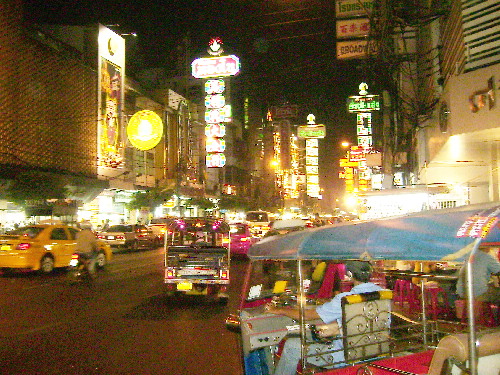
Chinatown at night, Bangkok
Sea Food
When night falls, roadside stalls in Chinatown suddenly appear and do brisk businesses, especially those that cater to food lovers like us. When we were there we looked for a sea food restaurant. We found one which was selling crabs, prawns, squids, snails, fish and cockles. The cooks could grill, steam and fry them for customers. Although they were not cheap we asked for a large crab and told a waitress to get it grilled over red hot charcoal. We tried other dishes too. We finished the delicious meal with some fleshy Siamese durians and a refreshing fresh coconut drink . Then we left Chinatown for our hotel.
Day 4: Friday, 7 December 2007
Thai Body Massage
On the morning of our last day in Bangkok, we went for a Thai body massage at a shop, Mr. Feet, which is a few doors away from our hotel, Bangkok City Inn. While we were fully clothed, our young masseuses expertly massaged our limbs and the back of our bodies. Occasionally, we felt a little pain in some parts of our bodies when strong pressure was applied. After having been massaged for an hour we felt relaxed and energized. All our muscular and joint pain due to walking too much during our last three days in Bangkok and Ayutthaya miraculously disappeared. Before we left the shop I saw a floating market in one of the large pictures printed by the Thai Tourism Board on a wall. We regretted to give it a miss as we had to depart for Malaysia in the evening.
Floating Market
In the early days, there were many floating markets in rivers and man-made canals or khlongs which were lined with dwelling-houses in Thailand. Later, when supermarkets were opened and people found it more convenient to shop at these places. Consequently, the number of floating markets dwindled a lot. Nowadays, there are few floating markets left in Thailand and they attract many tourists.
At a floating market, ladies in straw hats row about their small boats laden with fruits, vegetables, food, flowers, groceries, etc. looking for customers who usually live along the waterways. A busy floating market is a fascinating sight as you can see it in the photo on the left.
The largest floating market in Thailand is at Ratchaburi which is 101 km west of Bangkok. Small floating markets can be found in Bangkok, e.g. Tailing Chan and Wat Sai floating markets.
After a Thai body massage, we decided to walk to Phetburi Road nearby. While crossing a bridge over a large canal or khlong known as Khlong Saen Saep, we saw boats plying on the waterway.
Khlong Saen Saep
Khlong Saen Saep is a long canal connecting Khlong Phadung Krungkasem which flows into River Chao Phraya in the west to Prachinburi and Chachoengsao in the east. Today, it is a busy waterway which has 30 stops for over 100 passenger boats.
Originally, the canal was built to transport soldiers and weapons to Cambodia which was in conflict with Thailand during the reign of King Rama III.
After crossing the bridge we came to a long road, Phetburi Road.
Phetburi Road
Phetburi Road is a busy road lined with large buildings. It has a lot of traffic during day and night. Lots of stalls selling cheap food and snacks can be found on the roadside and five-foot ways in the morning. It is indeed a bustling place. Photos below show different types of stalls along the road.
From the Phetburi Road three tall building could be seen in the distance. One of them which was 88 storeys high, Baiyoke Sky Hotel, was the tallest in Bangkok.
Thailand General Election
While we were in Bangkok, the Thai people were gripped with a general election fever. The previous government of Prime Minister, Thaksin Shinawatra, was toppled by a military coup in 2006.
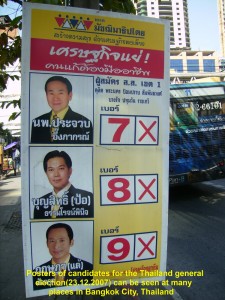
Posters of candidates for the Thailand general election 2007 can be seen at many places in Bangkok City
Posters of candidates standing for the coming Thailand general election on 23 December 2007 could be seen along major roads in the city. The photo on the right showing three candidates was taken along Phetburi Road. Besides, large portraits of the Thai king were put up in front of large buildings like hotels and government buildings in celebration of the king’s 80th. birthday.
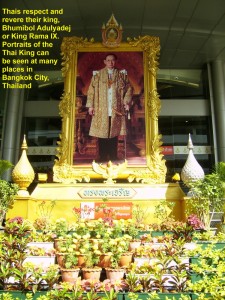
Thai King’s portraits can be seen at many places in Bangkok City, Thailand. The king is respected and revered by Thais.
While walking along Phetburi Road we were surprised to see lots of electric cables and telephone wires hanging untidily high above the road. It was undoubtedly an unpleasant sight.
Later we walked back to the budget hotel, Bangkok City Inn, claimed our luggage and took a taxi to the airport at 2.00 p.m. to check-in earlier before we departed for Malaysia at 6.00 p.m.
Bangkok City Inn
Located in Bangkok downtown, Bangkok City Inn is surrounded by many shopping centres which are within walking distance, including Central World, Zen, Big C, Siam Paragon, Siam Discovery, Siam Square, Siam Centre, MBK Centre, Gaysorn Plaza, Peninsula Plaza, Pratunam Complex and Amarin Plaza. In addition, bustling markets
and entertainment establishments are also nearby. The area is easily accessible by the Skytrain and some main roads. Taxis, tuk-tuks and buses are easily available here day and night.
We had stayed at Bangkok City Inn for three days and concluded that it is worth staying there. The rooms are clean and the bathrooms are large. The accommodation is inexpensive and free breakfast is provided daily in the clean and comfortable dining room. Its staff are helpful, friendly, and always smiling. They have made our stay a memorable one.
Check-In at Suvarnabhumi Airport
After checking-in at the airport we walked a long way to a place to wait for our plane. On the way, we came across a model of a royal Thai throne. Opposite the throne is a sculpture of a long serpent with a few heads, known as Vasuki, the “King of Serpents”. It is being pulled by several demigods and demons. There is a statue
of Vishnu Kurmavatara with four hands standing on a “mountain”. The “mountain” with the serpent round it is carried on a “tortoise’s” back. It is a beautiful sculpture.
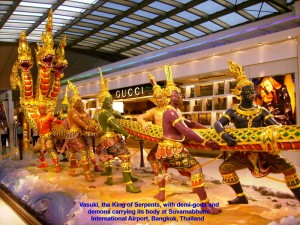
Sculpture of King of Serpents, demigods and demons at Suvarnabhumi International Airport, Bangkok, Thailand
Vishnu Kurmavatara
According to a legend about Vishnu Kurmavatara written on a board placed in front of the sculpture, I quote:
“This scene depicts Vishnu Kurmavatara and the churning of the Milk Ocean. The naga, Vasuki, (the King of Serpents) curled around the mountain, Mandara. Vishnu, incarnated in the form of a great turtle, supports the mountain on his back. Devas (demigods) and Asuras (demons) pull the naga’s body to churn the water of the ocean for thousands of years in order to produce the nectar of immortality, Amrita. From the churning, numerous opulent items are produced, including Dhanvantari carrying the pot of Amrita. In the end, the cooperation between Devas and Asuras is shattered. The Devas fulfill their plan of acquiring all Amrita and disperse the Asuras out of Heaven to the Underworld.”
Departure for Malaysia
Our air flight back to Malaysia was supposed to be at 6 p.m. but we departed Suvarnabhumi Airport at 7 p.m. On the way to Malaysia, my wife and I agreed that our three days’ stay in Bangkok was too short as we had missed many places of interest there. Anyway, we are now planning to visit another foreign place soon.
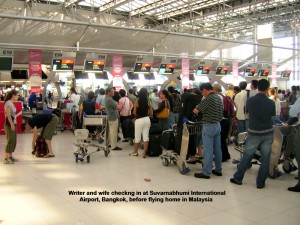
Writer and wife checking in at Suvarnabhumi International Airport before departure for home in Malaysia
Thank you for reading this travelogue and hope the information is useful to you.
Written by: Choo Chaw, Kluang, Johor, Malaysia

